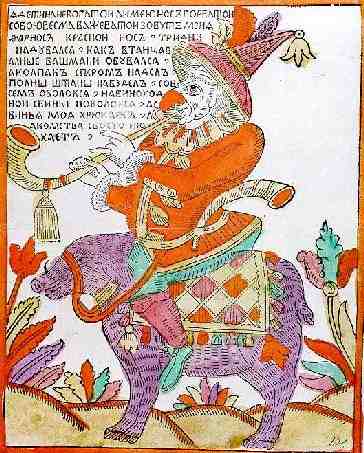
The images of fools, jesters, clowns, and dwarfs were brought to Russia by visiting foreign singers and comedians during the reign of Anna Ioannovna (1730-41) and Elizaveta Petrovna (1741-62). An interesting woodcut from the first half of the eighteenth century, The Female and Male Dwarfs, shows the title characters on a theater stage, exchanging compliments and making comments about their diminutive size.
Even more popular were foreign prints made by Jacques Callot (c. 1592-1635), a celebrated French engraver who worked in France and Italy. His clowns and jesters were quickly transformed into the funny Russian characters, Farnos, his wife Pigasya, Foma and Yerioma, Savoska and Paramoshka. Farnos and Pigasya, the red-nosed drunks, often have a good time in a tavern but regret it the next morning, when they have to deal with their hangovers and empty pockets.
They are slightly megalomaniacal and bombastic but always likable. The figure of Farnos might have been based on the court jester of Anna Ioannovna, the Italian fiddler Pedrillo, while his external appearance links him to the characters from Italian pantomime and the commedia del' arte (Pulcinello). He can be regarded as the prototype of the later Petroushka of the folk theater (Sytova, ill. 38). The best picture of this funny jester playing a pipe and riding a pig, with an appropriately ribald rhymed inscription, is Farnos the Red Nose. Pigasya appears with her husband in another woodcut, Brother Inn-keeper.
The brothers Foma and Yerioma, the perennial losers and oafs, known from a seventeenth-century story, always end up in trouble, often because they are stubborn, as in Foma, Paramoshka, and Yerioma. The sexton Paramoshka is paired with Savoska in Paramoshka and Savoska Played Cards, where he wins money from Savoska, unlucky as usual.